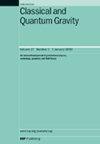在量子黑洞边缘寻找回声
IF 3.7
3区 物理与天体物理
Q2 ASTRONOMY & ASTROPHYSICS
引用次数: 0
摘要
我通过结合LIGO-Virgo-KAGRA合作观测到的47个双黑洞合并事件的引力波数据,对霍金辐射(或玻尔兹曼回声)的受激发辐射进行了基于模板的搜索。通过贝叶斯推断方法,我在3个引力波瞬变目录GWTC-1、GWTC-2和GWTC-3中都没有发现这种信号的统计学显著证据。虽然数据没有提供明确的证据反对玻尔兹曼回波的存在,但大多数事件的贝叶斯证据落在0.3-1.6的范围内,所有合并的共同(不消失)回波振幅的假设以2:5的赔率微弱不受欢迎。唯一的例外是GW190521,这是迄今为止观测到的最大规模、最可靠的探测事件,它显示出9.2的受激霍金辐射的积极证据。通过应用两种不同的方法在事件前后的真实数据中添加模拟信号来评估该异常事件的“寻找别处”效应,为较高的贝叶斯因子,(,)给出假(真)阳性检测概率。后验的最佳组合产生的上限A < 0.4(在90%置信水平)的普遍回波幅度,而在规范模型中预测。为了确保结果的健壮性,我采用了另一种方法分层地组合事件。该方法使用目标高斯分布,并从可能受选择偏差影响的多个不确定观测值中提取参数。本文章由计算机程序翻译,如有差异,请以英文原文为准。
Search for echoes on the edge of quantum black holes
I perform a template-based search for stimulated emission of Hawking radiation (or Boltzmann echoes) by combining the gravitational wave data from 47 binary black hole merger events observed by the LIGO-Virgo-KAGRA collaboration. With a Bayesian inference approach, I found no statistically significant evidence for this signal in either of the 3 Gravitational Wave Transient Catalogs GWTC-1, GWTC-2 and GWTC-3. While the data does not provide definitive evidence against the presence of Boltzmann echoes, the Bayesian evidence for most events falls within the range of 0.3–1.6, with the hypothesis of a common (non-vanishing) echo amplitude for all mergers being weakly disfavored at 2:5 odds. The only exception is GW190521, the most massive and confidently detected event ever observed, which shows a positive evidence of 9.2 for stimulated Hawking radiation. The ‘look-elsewhere’ effect for this outlier event is assessed by applying two distinct methods to add simulated signals in real data, before and after the event, giving false (true) positive detection probabilities for higher Bayes factors of , ( , ). An optimal combination of posteriors yields an upper limit of A < 0.4 (at 90% confidence level) for a universal echo amplitude, whereas was predicted in the canonical model. To ensure the robustness of the results, I have employed an additional method to combine the events hierarchically. This approach involves using a target Gaussian distribution and extracting the parameters from multiple uncertain observations, which may be affected by selection biases.
求助全文
通过发布文献求助,成功后即可免费获取论文全文。
去求助
来源期刊

Classical and Quantum Gravity
物理-天文与天体物理
CiteScore
7.00
自引率
8.60%
发文量
301
审稿时长
2-4 weeks
期刊介绍:
Classical and Quantum Gravity is an established journal for physicists, mathematicians and cosmologists in the fields of gravitation and the theory of spacetime. The journal is now the acknowledged world leader in classical relativity and all areas of quantum gravity.
 求助内容:
求助内容: 应助结果提醒方式:
应助结果提醒方式:


